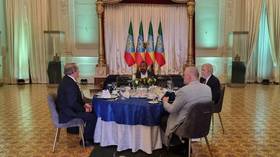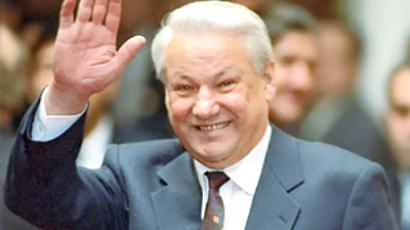Ceausescu trial: as it was
Twenty years ago, a violent revolution in Romania ended the era of Nicolae Ceausescu, who ruled the country for over two decades. The path from dictatorship to democracy for the country was a bloody one.
After a very brief trial lasting about an hour, Nicolae Ceausescu and his wife Elena were found guilty of a number of what are termed “grave crimes” against the Romanian people, such as gathering illegal wealth and genocide.
On Christmas Day 1989, Nicolae Ceausescu and his wife Elena were shot by firing squad.
It brought to an end ten tumultuous days of death and civil unrest.
20 years on, the picture of how and why things happened so fast remains unclear.
RT spoke exclusively to General Dan Voinea, who was the military prosecutor at the Ceausescus’ trial.
RT: Can you quickly run us through the background of how Ceasescu and his wife ended up on trial in front of you?
Dan Voinea: The Romanian people were unhappy with the Communist leadership because it impoverished them. People literally had nothing to eat. It was incredibly difficult to find even basic food. For example, bread was rationed. Sugar and butter, too. And petrol.
Moreover, people were constantly under pressure. Ceausescu, this dictator, used his instruments of power allegedly to ensure Romania’s security. In reality, though, this meant the Romanian people were persecuted and harshly punished for any ideas dissenting from Communist ideology.
In addition, there was no freedom of movement. People were not allowed to travel freely, both within the country and abroad. Also, there was no freedom of speech. You can even say that freedom – freedom of movement, freedom of speech – was more important to people than food and order.
Gorbachev’s reform in the Soviet Union and the following events in Eastern Europe, where most of the countries in the Communist Bloc abandoned communism, further spurred anti-communist sentiment in Romania.
The country was caught up in anti-communist demonstrations. The first one took place in the town of Timisoara on December 17, 1989. Protesters marched through the streets. They did not attack any military installations or any other buildings; they only attacked the offices of the Communist authorities.
As you know, the demonstration was broken up harshly. Those were the bloodiest events in all the countries of the Eastern Bloc. They were caused by continuous persecution initiated by the authorities, by the Ceausescu family, who were practically running a Communist dictatorship in Romania.
However, this did not stop people from protesting. On the contrary, protests erupted throughout the country. Eventually, protesters stormed the office of the Communist Party’s Central Committee in Bucharest, which was, as it were, the stronghold of Communist forces.
Ceausescu was inside the building at the time. Fearing for his life, he fled in a helicopter, but later in the day he was captured and delivered to a military base, where he was kept until December 25, 1989, when he was tried by a military tribunal.
RT: Why was it so hurried?
DV: That was what the people wanted. Had the trial taken a longer time, there might have been more casualties.
Ceausescu had many friends, many people whom he had helped, many relatives, many activists in various government bodies. They could come to his rescue.
Technically, the trial was arranged by the military, by then-Defense Minister Victor Stanculescu. It was he who told us we had one hour for the trial. The trial started at 2pm and was over by 3pm, December 25, 1989.
By that time, people throughout Romania were calling for Ceausescu to be tried. They were demanding that Ceausescu be punished for all the blood he shed.
This was a fair trial of Ceausescu as a dictator who had oppressed the Romanian people.
People could not take it any longer. They were demanding a trial. However, nobody told us that after the trial the Ceausescus would be executed.
This decision was made by General Stanculescu and those who came to power – Ion Iliescu, Petre Roman and others. Petre Roman openly wrote about this in his memoir. Later, he was appointed Prime Minister.
RT: What was the atmosphere like?
DV: The Ceausescus declared they did not recognize the authority of the military court. In reality, according to a law Ceausescu established himself, the military were allowed to perform judicial functions.
In case of emergency, the Army had the right to set up military tribunals in addition to regular courts. So, the tribunal was fully legal; there was no question about that. But Ceausescu arrogantly refused to recognize the military tribunal and declared he wanted to be tried by the Great National Assembly. Also, he objected to the composition of the judging panel.
After reading the death sentence, the tribunal chairman suggested that Ceausescu file an appeal. Had Ceausescu appealed the sentence, the execution would have been delayed for three days and things might have been different. But they refused to appeal and were executed right away.
An execution squad of five soldiers took the Ceausescus outside the courtroom, led them through a 10-yard corridor, brought them outside the building, led them to a concrete wall and shot them.
RT: How did Ceausescu and his wife behave?
DV: In terms of emotions, they defied the judicial system they themselves established in Romania. They had to give an account for all those people who were executed without a trial, on their orders, simply because they came out to the streets and defended their rights. The Ceausescus were almost emotionless. They did not weep. On the contrary, they criticized their judges.
As I already mentioned, they insisted that their case be heard in the Great National Assembly.
In fact, the Assembly had already been dissolved by that time. In this way, the Ceausescus demonstrated their disregard for law. They refused to acknowledge that everybody is equal before law.
As for the execution itself, I can only say that everything happened very quickly. I think they did not have time to realize what was happening to them. I remember how Elena cried, complaining that her wrists were hurting because of the rope. The executioners led them away very quickly. They did not want cameramen to take any pictures of the execution itself, because they were afraid that the footage may be later used as evidence against them.
So, the execution itself was not taped. The only pictures taken show the bodies of the Ceausescus lying on the ground.
RT: What do you say to the speculation that the overthrow of Ceausescu was a coup orchestrated from outside the country?
DV: Indeed, there is such a theory. But reality has proved otherwise. There was no interference by the Russians or by anybody else. We never found any evidence of foreign involvement in the revolution.
There was speculation about thousands of Russians, who supposedly drove from Bessarabia and Ukraine, posing as tourists in order to initiate the revolutionary movement. But this cannot be true. Russian tourists were merely driving through Romania on their way to Yugoslavia and stayed away from the conflict as much as they could.
Perhaps the Ceausescu regime invented these theories in order to justify their actions and be pardoned for what they did.
RT: During the revolution there was a lot of disinformation about things like the death toll among protesters and others. How much did that affect the outcome of the trial?
DV: This was done in order to paint anti-Communist protesters as terrorists. Initially, the authorities did not interfere. But when protesters began to storm Party offices, the authorities announced that the buildings were being attacked by terrorists. Based on this claim, armed soldiers were posted outside to protect Party offices from terrorists.
The Communists used these claims to protect their institutions. Thus, the Communist authorities were unharmed. There were no Communist officials among the casualties. There were only students, farmers, and workers among the victims.
RT: At the time, did you realize you were taking part in such an historic moment?
DV: In December 1989, I was a military prosecutor with Romania’s Prosecution Service. When the time came to decide who would preside over the military tribunal, all my colleagues refused. I was the only one who volunteered to do it. This was an unprecedented situation.
At first, we didn’t know the trial would be over so soon. We thought we’d be given enough time to gather evidence and expose the criminal nature of Ceausescu’s regime.
I realized this was a special event. It was special for me as a prosecutor, too. This was a unique situation. That’s why I volunteered when everybody else refused.
RT: Looking back do you think Romania was fair to Ceausescu?
DV: The conclusion of the trial was shocking. But at that time, there was no rule of law in Romania. Romania was a dictatorship. The Romanian people considered the situation and made their choice. They demanded that the Ceausescus be tried, which is what we did. Technically, the trial procedure was not perfect; but at that point people cared more about justice than about procedural matters. It was a matter of saving the freedom and lives of people who were bold enough to rise up against the dictatorship of the Communist elite.
Each year, when Romania marks the anniversary of the revolution in December, people start criticizing the trial. But you need to remember that the trial was taking place under special circumstances: the political situation in Romania had reached an aggressive and bloody stage, and it was impossible to have a normal trial. Of course, we would have preferred the trial to take a longer time, as it should. But then everything might have ended differently.












